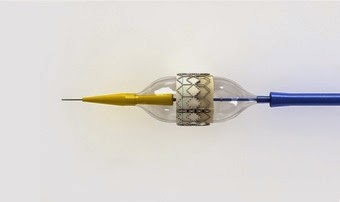What is an Ebola?
Ebola is a virus
disease—also called Ebola haemorrhagic fever. It was discovered by scientist the
virus in 1976 in the Democratic Republic of the Congo. The virus gets its name
from the Ebola River near where five strains of the virus were found.
 |
| Ebola Virus |
Does Ebola Spread through direct contact?
Ebola is not an
airborne virus unlike common cold or flu. Instead, the Ebola virus spreads from
coming into direct contact with blood, bodily fluids, or infected objects—such
as needles, clothing or bedding. Body fluids include urine, faeces, saliva,
mucus, vomit, breast milk, and semen. The virus can enter the body through
broken skin or mucous membranes in your mouth, throat, nose, eyes, genitals
or anus.
Diagnostic issues
Difficult to
diagnose as it mimics common flu along with fever, cold, body ache. In some
cases, external bleeding may happen which are dangerous and the patient may
struggle to survive without intensive care. Incubation period is 2 to 21 days.
 |
| Symptoms Of Ebola |
What is the treatment plan for Ebola
Doctors treat patients
with supportive measures which includes giving IV fluids and electrolytes,
providing oxygen, maintaining blood pressure, treating other infections, and
relieving symptoms.
Currently, no specific
drug is available. There are Ebola vaccines in developmental stage of research.
Is it a fatal disease?
A person’s
recovery depends on the strength of their immune system and the supportive care
they receive. Early diagnosis is crucial. Once people recover from Ebola, they
have antibodies to the disease which protects them for at least 10 years. Usually
people with low body defence such as; Geriatrics, Paediatrics, AIDS patients,
DM, etc., are vulnerable to this disease.
Avoiding Direct Contact Is the Main
Prevention
For public, avoiding
contact with blood, bodily fluids, and contaminated objects is the main way to
prevent Ebola. Careful hygiene is the best way to avoid any infectious health
risk. Also, alcohol and bleach based disinfectants quickly kill the Ebola
virus.
For healthcare
providers, the standard precautions—gowns, gloves and masks—are always a must,
regardless of a person’s health status. Healthcare workers and others caring
for a patient with Ebola must take extra precautions including isolating the
patient, wearing full coverage protective clothing, and practicing proper
infection control.
Is Ebola Rare?
Ebola is a rare,
but serious viral disease. In the nearly 40 years since its discovery, there
have been about 25 outbreaks in African countries. About 2,500 people were
infected during all these outbreaks. Compare that to the 2012 U.S. outbreak of
whooping cough when nearly 50,000 people got sick in one year, and you can see
how rare Ebola is. The current Ebola outbreak in Africa is getting widespread
attention because it is larger than previous outbreaks and affects multiple
countries.
Is It Safe to Travel With Someone Sick With
Ebola?
People with Ebola
have to have symptoms to spread the disease. Before symptoms develop, people
aren’t contagious. You must come into direct contact with bodily fluids after a
person exhibits symptoms. Being on an airplane or in an airport with a person
infected with Ebola who does not have symptoms is a low-risk situation. This
means it’s unlikely that you would acquire the infection.
Is There a Vaccine for Ebola?
 |
| Symptoms Of Infections |
Currently, there
is not a vaccine in use for Ebola, but scientists are working on one. A vaccine
works by stimulating the immune system to fight off a specific infection if or
when it occurs. Vaccines act to prevent the disease instead of treat the
disease. The National Institutes of Health recently announced that a new
vaccine is in early clinical trials to see how safe it is in people and if it
stimulates the immune system.
Source:http://www.healthgrades.com/conditions/6-things-you-need-to-know-about-ebola











